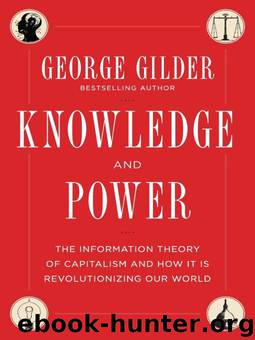Knowledge and Power: The Information Theory of Capitalism and How it is Revolutionizing our World by George Gilder

Author:George Gilder [Gilder, George]
Language: eng
Format: mobi
Publisher: Regnery Publishing
Published: 2013-06-09T14:00:00+00:00
In the lead-up to the collapse, Greenspan “created a structure of negative real interest rates,” forcing rates down to 1 percent, encouraging and providing incentives to banks and borrowers to buy and sell poisoned products—and to take on vast amounts of shaky debt and leverage which could not be sustained if higher real interest rates returned.
Enter Ben Bernanke, former Princeton economist and Fed vice chairman under Greenspan: “After he became chairman [in 2006] Bernanke rapidly raised interest rates and created an inverted yield curve” (higher short-term rates than the high long-term rates). But homeowners, businesses, and banks, lured by the Fed into leverage and cheap loans, could not finance the Greenspan interest-rate increases, followed by Bernanke’s abrupt move to raise the federal funds rate (the interest rate the Fed charges banks) to 5.25 percent.
The impact of such an interest rate move (from 1 percent to 5.25 percent) must be thought of as a price increase of 500 percent plus—similar to an increase in the price of a loaf of bread from $2.50 to $15. Remember that Americans (and consumers worldwide) had borrowed and leveraged themselves during the period in which Alan Greenspan forced the federal funds rate down to 1 percent….
Then Bernanke “held the inverted yield curve for more than a year (from July 2006 to January 2008), one of the longest yield-curve inversions ever.” And inverted yield curves historically lead to recessions. In a word, according to Allison, the Federal Reserve was both the fundamental cause of the real estate bubble and the agent of its collapse. But Bernanke “was adamant that there would not be a recession.”
Allison’s conclusion?
In my career, the Fed has a 100 percent error rate in predicting and reacting to important economic turns … [because it] is trying to arbitrarily set the single most important price in the economy—the price of money.
And yet, as we know, setting wage and price controls, from the time of Diocletian to Richard Nixon, has proven in every case a disaster for economies and the people entrapped by them.7
In pithy and persuasive prose, Allison and Wilmers—two good bankers—provided the most powerful explanations of the crisis. Yet it is the dancing princes and crony capitalists who remain in control of American banking and monetary policy.
Download
This site does not store any files on its server. We only index and link to content provided by other sites. Please contact the content providers to delete copyright contents if any and email us, we'll remove relevant links or contents immediately.
| Anthropology | Archaeology |
| Philosophy | Politics & Government |
| Social Sciences | Sociology |
| Women's Studies |
The Secret History by Donna Tartt(18714)
The Social Justice Warrior Handbook by Lisa De Pasquale(12073)
Thirteen Reasons Why by Jay Asher(8725)
This Is How You Lose Her by Junot Diaz(6694)
Weapons of Math Destruction by Cathy O'Neil(6076)
Zero to One by Peter Thiel(5629)
Beartown by Fredrik Backman(5538)
The Myth of the Strong Leader by Archie Brown(5365)
The Fire Next Time by James Baldwin(5192)
How Democracies Die by Steven Levitsky & Daniel Ziblatt(5090)
Promise Me, Dad by Joe Biden(5032)
Stone's Rules by Roger Stone(4984)
100 Deadly Skills by Clint Emerson(4790)
A Higher Loyalty: Truth, Lies, and Leadership by James Comey(4777)
Rise and Kill First by Ronen Bergman(4647)
Secrecy World by Jake Bernstein(4588)
The David Icke Guide to the Global Conspiracy (and how to end it) by David Icke(4545)
The Farm by Tom Rob Smith(4401)
The Doomsday Machine by Daniel Ellsberg(4371)
